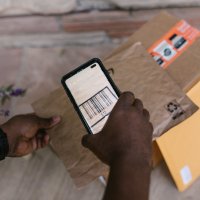How to Avoid Shipping Label Barcode Scanning Errors
 Each shipping label has a unique barcode that contains encoded information essential for automated sorting and tracking systems. If the barcode is damaged or barely visible, your package may get delayed or even lost, so it’s important to make sure the barcode is scannable when you print shipping labels yourself. How to avoid shipping label barcode scanning errors?
Each shipping label has a unique barcode that contains encoded information essential for automated sorting and tracking systems. If the barcode is damaged or barely visible, your package may get delayed or even lost, so it’s important to make sure the barcode is scannable when you print shipping labels yourself. How to avoid shipping label barcode scanning errors?
To understand how to avoid barcode scanning errors you need to understand how barcode scanners work. A barcode consists of black and white bars that reflect light differently. Barcode scanners shine red light on a barcode and capture the reflected light with a sensor. The analog signal is converted into a binary digital signal, which is then sent to a computer software application that translates the signal into information encoded in the barcode.
Scanning errors occur when some parts of the barcode don’t reflect light as they should. This can happen when the barcode is too pale, wrinkled, damaged, or covered with clear packing tape that also reflects light. What steps can you take to ensure the barcode remains scannable and avoid barcode scanning errors?
Check Your Printer
First, check the printer settings to make sure the label size and paper orientation are right and the barcode won’t get cut off. Then make sure there’s enough ink if you’re using an inkjet printer or enough toner in the cartridge if you’re using a laser printer. Print a test page before printing the shipping label to make sure there’s enough contrast. If the shipping label is too pale or blurred, find another printer and reprint it. And, of course, you should stick to regular white paper and black ink; don’t experiment with colors.
Let the Ink Dry
If you’re using an inkjet printer, let the ink dry before attaching the label to the package to avoid smudges and smears that can make the label hard to scan.
Make Sure There’s Nothing Underneath the Label
If you stick the shipping label on top of old labels or markings that may be on the box, they may bleed through and cause the light from a barcode scanner to reflect differently. So it is important to remove any leftover labels, stickers, or markings when reusing an old shipping box.
Attach the Label Properly
For the barcode to remain scannable, the shipping label should be attached to the box in a proper way. You should place it on the largest side of the package, which is called the address side. When mailing something in tube packaging, make sure the barcode is placed lengthwise.
If the shipping label is too big and won’t fit, scale it down and print a new one because you must not fold or bend the label over the edge of the box. Avoid creases and wrinkles when attaching the label; this means that you should smooth it out and avoid placing the label over a seam.
Don’t Use Reflective Materials to Protect the Label
It’s important to protect the shipping label from the elements, but if you use reflective materials for protection, they can make the label harder to scan. The best solution is to get a special address pouch from your shipping carrier of choice; address pouches are properly sized, waterproof, self-adhesive, and clear yet not reflective. If you choose to protect your shipping label with clear packing tape, do not tape over the barcode.
Put a Backup Copy of the Label Inside the Package
Even if you take all necessary precautions, there’s still a chance that the shipping label will get damaged or torn off the package. To keep your package from getting delayed or lost in transit, you should put a backup shipping label inside the box.
As you can see, it’s not that hard to ensure your shipping label stays scannable and avoid barcode scanning errors. If you take the precautions we’ve described above, your package should arrive to its recipient on time without any trouble.